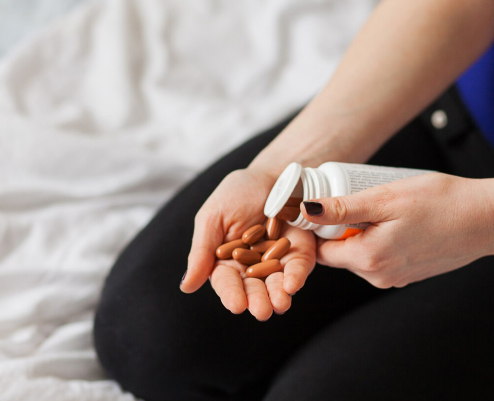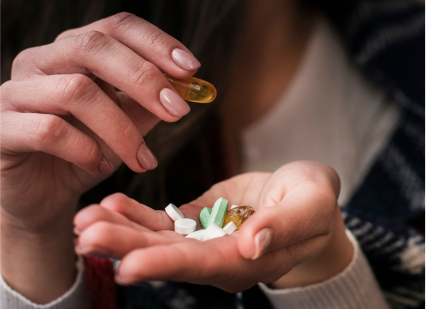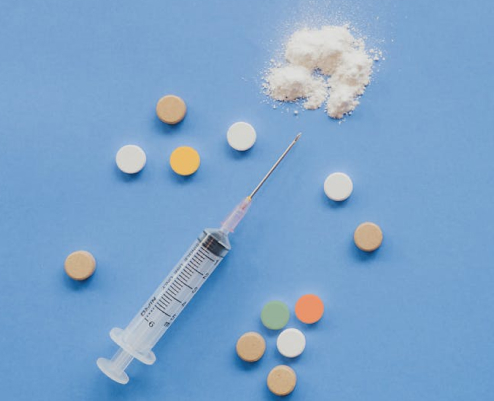Ecstasy is a recreational drug that has mood-enhancing and energizing properties. It also know as MDMA. This drug is commonly used as a party drug, but not many are aware of some severe consequences its use might have on a person’s physical and mental health.
It is important to know how this drug is classified and how it affects a person’s body and mind. Is ecstasy a depressant or stimulant? What are its side-effects? How dangerous is it to use it regularly? We will discuss short and long-term effects of ecstasy use and potential risks of addiction in order to help you recognizes signs of drug abuse in yourself or a loved one.
Skip to:
What is Ecstasy?
Ecstasy is a synthetic drug that alters mood and perception and it is also called MDMA (3,4-methylenedioxymethamphetamine.) It is chemically similar in action to both stimulants and hallucinogens and results in heightened energy, pleasure, emotional warmth, and distorted sensory and/or time perception.
Ecstasy is usually consumed in tablet form but can also be found in capsules or as a powder. Common street names are Molly, X, E, and XTC. MDMA usually lasts for three to six hours. On the other hand, euphoria or “molly” side effects can often last for a day after use. The sensations might even last for a week or more, particularly if MDMA is combined with other substances like marijuana.

Ecstasy was synthesized in 1912. it was produced by German drug company Merck but wasn’t commonly used until in the 1970s and 1980s in nightclubs and rave scenes. It was first used in psychotherapy but became recreational rapidly.
As opposed to other recreational drugs like nicotine and cocaine, which come from plants, MDMA, often known as ecstasy, is made by changing the structure of the amphetamine molecule. It is illegal in many countries due to its abuse potential and toxic effects. Ecstasy has dangerous short and long-term health effects despite its popularity.
Potential Medical Applications of Ecstasy
MDMA has not been licensed by the Food and Drug Administration (FDA) of the United States to treat any medical condition. To expedite research on MDMA as a treatment for PTSD, the FDA has, however, classified it as a breakthrough medication. During research trials, MDMA is always given under medical supervision and is typically used together with other therapies like talk therapy. For instance, a 2021 research discovered that medical MDMA treatment for autistic people with social anxiety disorder reduced symptoms of the disease, including shame, self-criticism, and feelings of social danger.

Concerning Ecstasy Statistics
Teenagers or young adults make up most of the MDMA consumers. In 2019, there were 3,792 admissions to publicly funded substance use treatment involving ecstasy. According to the 2020 Monitoring the Future poll, 2.7% of students in the 12th grade reported using ecstasy during the previous year.
In all young adult age groups, perceived danger of experimenting with MDMA (ecstasy and, more lately, Molly) dropped in 2020. This is a cause for concern as it shows that young people are not fully aware of the risks of using ecstasy.
These figures demonstrate how common ecstasy use is, particularly among young adults and teens, underscoring the importance of ongoing education and preventative initiatives. Don’t hesitate to contact us for additional information and advice.

Depressants vs. Stimulants
Depressants slow the activity of the central nervous system. They can relax you, reduce anxiety, and help with sleep. But, they also induce drowsiness, impaired coordination, and lower inhibitions. They’re prescribed for anxiety, sleeplessness, and seizure disorders, although they are dangerous and addictive when abused. Common depressants are:
- Alcohol
- Benzodiazepines (Valium and Xanax)
- Barbiturates
On the other hand, stimulants enhance the nervous system activity. They improve alertness, attention, and energy, but they also raise your heart rate and create anxiety and restlessness. Stimulants are often used to treat ADHD and narcolepsy but can also be addictive and can be extremely bad for health if abused.
Knowing these differences enables you to know how substances affect your mind and body. Popular stimulants include:
- Caffeine
- Nicotine
- Cocaine
- Amphetamines (like Adderall and methamphetamine)
How Ecstasy Affects the Brain? Is Ecstasy a Depressant?
Ecstasy increases three neurotransmitters in the brain: serotonin, norepinephrine, and dopamine.
Serotonin regulates mood, appetite, and sleep. Ecstasy floods your brain with serotonin and it’s the cause of euphoric feelings, emotional closeness, and elevated mood. Dopamine increases pleasure, reinforces behavior, and makes the drug addictive. Norepinephrine also causes an increase in heart rate and blood pressure. This combination of these activities is what makes ecstasy so powerful and enjoyable, and also addictive.
If you are struggling with ecstasy use, it’s important to tell someone about your addiction to get the support and help you need.

Short-term and Long-term Effects
Short-term effects of ecstasy on mood/energy include increased happiness, sociability, and energy. Users report increased sensory perception and emotional involvement with others. But they may be accompanied by negative effects including anxiety, nausea, and dehydration.
In the long term, ecstasy may cause brain damage. Constant usage can lead to memory problems, depression, and anxiety. It depletes serotonin levels, which may bring about lasting changes in behavior and mood. Persistent use may also promote addiction and cognitive impairments.

Get Your Life Back
Find Hope & Recovery. Get Safe Comfortable Detox, Addiction Rehab & Dual Diagnosis High-Quality Care.
Hotline (855) 459-2880Is Ecstasy a Depressant or Stimulant?
Is ecstasy a stimulant or depressant? Ecstasy (MDMA) mainly contains stimulants that give users more energy and alertness so they feel awake and active. This is because of a surge of neurotransmitters such as dopamine and norepinephrine. Users report higher sensory perception, greater awareness of their surroundings, and stronger emotions. These stimulant effects are why ecstasy is popular in party and rave scenes, where increased energy and sensory experiences are sought after.
However, ecstasy has some depressant side effects. After the high, users may feel depression and anxiety. This is because serotonin levels in the brain are depleted following ecstasy use. The come-down period may include fatigue, mood swings, and issues concentrating. Such aftereffects may resemble those from a depressant in which users become low and anxious.

Therefore, ecstasy has both stimulant and depressant properties. It’s a stimulant when used to boost power and sensory perception but can have depressant-like side effects including anxiety and depression. This dual nature makes it a complex drug with several effects on the brain and body. Understanding these effects allows risk identification and responsible usage. Our addiction treatment Florida center is at your disposal in case you need consultation or professional advice.
Risks and Side Effects of Ecstasy Use
The use of ecstasy poses serious threats to one’s physical health. The drug can cause severe hyperthermia (a possibly fatal increase in body temperature) and dehydration in environments such as clubs or parties where users remain active for long periods. This may cause dangerous complications like heatstroke or kidney failure.
Ecstasy may also increase heart rate and blood pressure—which could result in heart disease in some people. Regular use may also damage the liver and immunity system and make the body more vulnerable to illnesses. Ecstasy overdose symptoms can include faintness, panic attacks or extreme anxiety, high blood pressure, and seizures. Overdose is rare but can be life-threatening.
Ecstasy can also affect mental health. It may improve energy and mood, but the side effects are extreme depression and anxiety. Users report feelings of sadness and irritability because serotonin levels drop. Longevity of use may cause memory problems and other cognitive impairments. Additionally, ecstasy has the potential for addiction and dependence—and users may not be able to quit despite negative effects.
Seeking Help for Ecstasy Addiction
Recognizing an ecstasy addiction early can make a significant difference in recovery. The symptoms of ecstasy addiciton could include persistent cravings, mood swings, or neglecting obligations. Knowing these signs may help you find timely support. Ignoring addiction may cause serious health and personal problems. Awareness is the first step towards a more healthy lifestyle! Take action in case you or somebody you know is struggling.

Ecstasy addiction treatment options are diverse and effective. Level Up Lake Worth creates programs to meet your individual needs. They include drug detox in Florida, counseling and support groups. Their professional staff is there for you during your recovery. By picking a specialized facility you increase your chances of a full recovery. It is a brave step to request help.
Ecstasy Use and Recovery: Reach Out for Support Today
When discussing the effects of MDMA, a common question that arises is, “Is ecstasy a depressant or stimulant?” Ecstasy is mainly a stimulant with several hallucinogenic effects. Understanding its classification helps recognize its effect on the body and mind. To prevent misuse and addiction education and awareness are needed.
In case you or someone you care about struggles with ecstasy use, reaching out could make a big difference. Reach out to We Level Up Lake Worth FL team of experts for professional support and guidance. We can customize treatment for you at our Lake Worth FL rehab center. Don’t hesitate to ask for further info or assistance. Call us or visit our website for recovery resources and start building a happier life!
Start a New Life
Begin with a free call to an addiction & behavioral health treatment advisor. Learn more about our dual-diagnosis programs. The We Level Up treatment center network delivers recovery programs that vary by each treatment facility. Call to learn more.
- Personalized Care
- Caring Accountable Staff
- World-class Amenities
- Licensed & Accredited
- Renowned w/ 100s 5-Star Reviews
We’ll Call You
Sources:
Abuse, N.I. on D. (2024a). MDMA (Ecstasy/Molly) | National Institute on Drug Abuse (NIDA). [online] nida.nih.gov. Available at: https://nida.nih.gov/research-topics/mdma-ecstasy-molly.
Abuse, N.I. on D. (2024b). Psychedelic and Dissociative Drugs as Medicines | National Institute on Drug Abuse (NIDA). [online] nida.nih.gov. Available at: https://nida.nih.gov/research-topics/psychedelic-dissociative-drugs-medicines.
SAMHSA (2020). National survey on Drug Use and Health | CBHSQ. [online] Samhsa.gov. Available at: https://www.samhsa.gov/data/data-we-collect/nsduh-national-survey-drug-use-and-health.
SAMHSA (2023). SAMHSA Announces National Survey on Drug Use and Health (NSDUH) Results Detailing Mental Illness and Substance Use Levels in 2021. [online] HHS.gov. Available at: https://www.hhs.gov/about/news/2023/01/04/samhsa-announces-national-survey-drug-use-health-results-detailing-mental-illness-substance-use-levels-2021.html.





